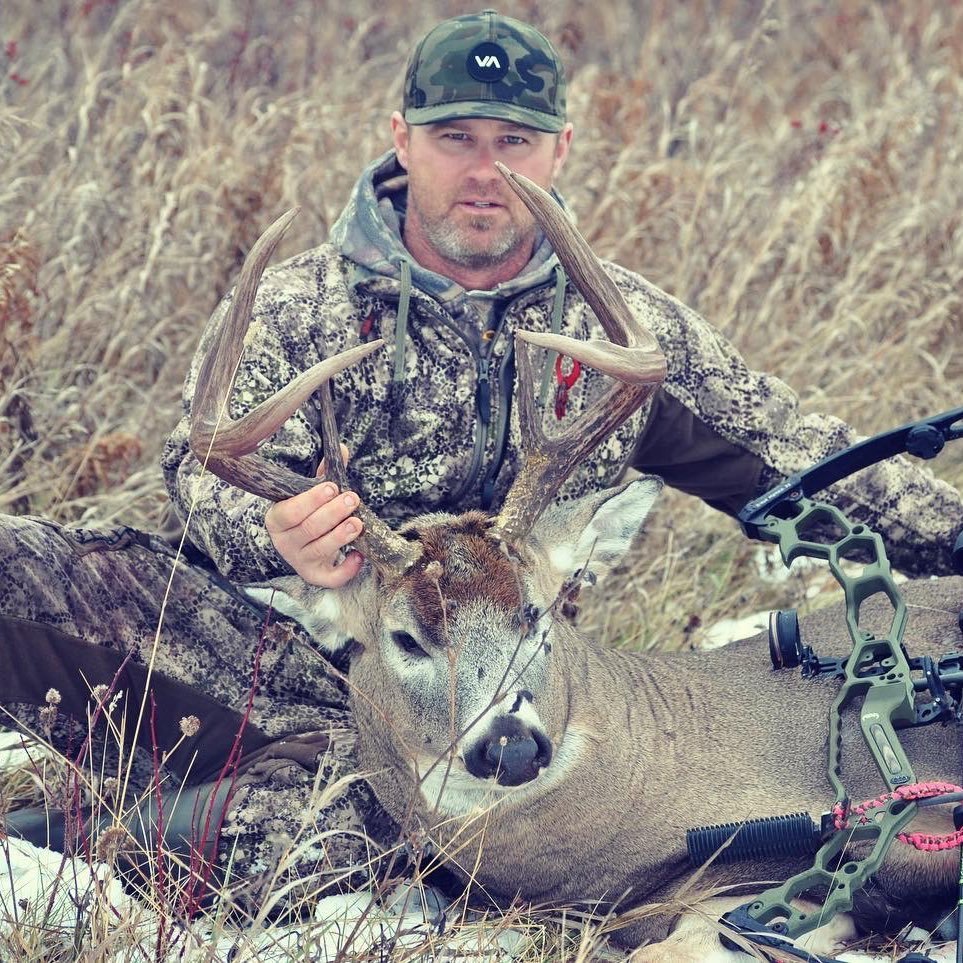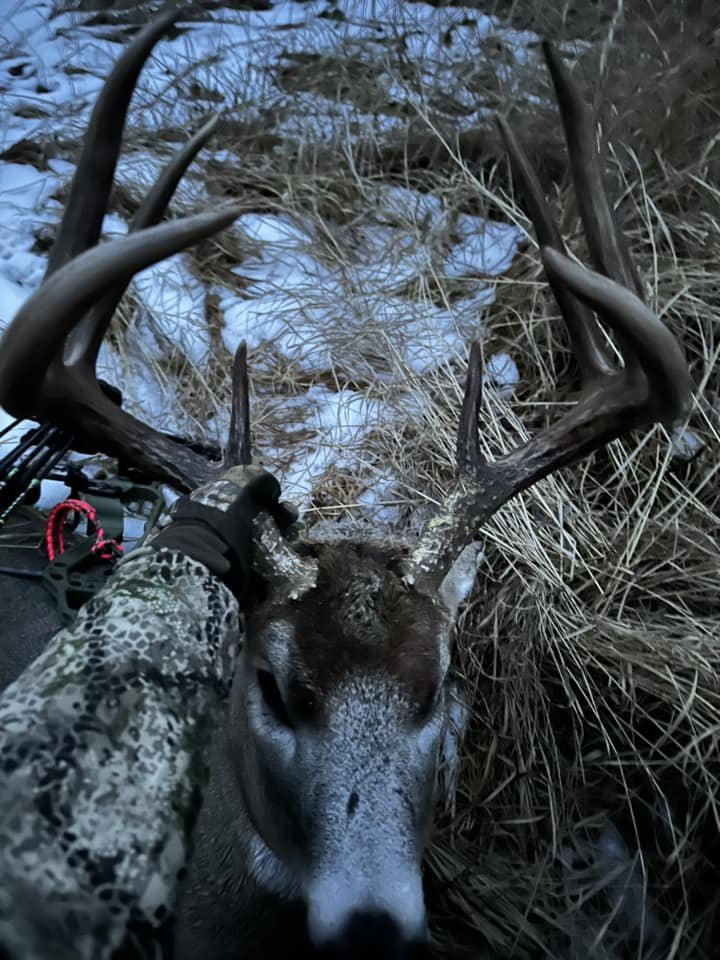Chasing 170 “A Great 8”
Field Photo: Field photo taken by friend Jim Zinyk of Kinuso, Ab. APA Black Mamba 33, 80# & 30” Draw Length. Easton Axis 5mm with 75grain insert and 100grain MontecG5 broadhead.
Hunting seasons seem to come and go faster these days. The older I get, the more years seem to blend into one another. That said, the transition from one hunting season to another never seems fast enough. This season was no exception.
My 2022 season was a success in most respects. I was able to shoot a mature buck with my bow on video, and that’s my bottom line for a season these days. Ultimately, however, like most other archery hunters, my goal is to join the ranks of those entered in the Pope and Young history books. Clearly, this is a formidable challenge.
While luck plays a huge role in Whitetail deer hunting, the importance of preparation and execution cannot be underestimated. Determining where bucks spend their daytime hours, waiting for the right conditions, and then executing a perfectly timed shot are the keys to success. There are no shortcuts or archery "hacks" when bow hunting mature whitetails. The key to success is hard work and discipline.
My hunting season typically commences shortly after the last season ends. After a short break, I’m back in the bush retrieving pictures from my trail cameras and studying what these animals are doing during the months of November and early December when no one is around. This is vital information, especially if you find yourself with a tag in your pocket for that time next season. With the cold Alberta winters, late December and January are best spent in the warmth of your home dreaming of sending a perfect arrow through a 175” mainframe 6x6 once the snow melts.
August is my favorite time of year to narrow down where
my target bucks are daytime active. Photo taken with
Meyer HL2 trail cam.
Like many of my hunting comrades, shed antler hunting is not only a great way to get back outdoors in the spring, it’s also a great way to locate key bedding areas near your hunting spots without the real risk of blowing deer out of the area for your hunting season. It helps add a greater overall understanding of the property you intend to hunt on. During this part of the season, snow is all but gone and all the evidence of the past season is there for the taking. Game trails stand out clearly and old rubs and scrapes are easy to spot in the absence of thick vegetation. Freshly shed antlers seem to perch boldly on top of the barren ground as the snow rescinds another season. Every little detail must be considered when building a game plan for a successful upcoming season. The more data and details you collect, the more prepared you will be.
Preparation is key.
So, now that we have spent some time over the end of the winter and the beginning of spring trying to increase our odds for success in the fall, we now have to make sure that we are not “delusional” and the areas we think are holding deer actually hold some deer. This is when my favorite time of year starts—trail camera season, a.k.a. the growing season. For many years, I put my trail camera fleet out as soon as the snow melted only to find myself looking at thousands of photos of what turned out to be the same deer. I found it almost impossible to differentiate between mature bucks because they had not started growing their antlers yet. In recent years, I have learned that mid-June seems to be an ideal time to put my cameras out. Not only can I quickly tell differences between bucks, but I am able to minimize the footprint I have left on my hunting areas. With each passing year, I quickly learn how vital this is. If I’m being honest, in my younger days as a hunter, I just couldn’t contain my excitement for hunting. I grew up in Nova Scotia, which has very limited hunting opportunities. Alberta was a bit of a wonderful shock to a young hunter. Big deer seemed to be around every corner, and no matter how hard I tried, I could not, for the life of me, stay away from my trail cameras. I checked them obsessively, at every opportunity. In retrospect, this likely caused some of the issues I had when hunting big bucks. Mature bucks have very little tolerance for humans and are much more intelligent than I gave them credit for at that point in my hunting career.
As summer progresses and hunting season inches closer, your physical impact/imprint on your hunting grounds becomes more and more critical. The last thing you want to be doing is moving stands, cameras, or gear around during hunting season. In my opinion, it’s too late at that point. The groundwork for a successful hunting season is done during the spring and summer. In mid-July, I got a trail cam photo of a deer I instantly wanted to target. The next day, I got to work. Having trail cameras is great, but using them effectively and efficiently is key. I mean, what purpose is served by having one photo of a deer on your trail camera in the month of August other than knowing he is in the area in August? You can, however, greatly increase the photo’s value by investigating environmental conditions on the day the image was captured. What was the wind direction? What were the temperature and other weather conditions? What was the moon phase? Each piece of information you accumulate can improve odds for success during the upcoming season.
Photo Caption: A curious fawn separates itself from the herd to follow it’s nose.
Photo Caption: Loaded up and headed home. Non-Typical Nation style.
Execute. Tree selection is key!
Picture Caption: The day after getting a trail cam photo I built this tree stand.
I spent a good part of the morning sourcing materials from the local landfill woodpile, then set out to pick the right spot to build a stand. Wind direction is the most important factor for archery deer hunting. I decided to set up on an inside corner of a field which would allow bucks to have a northwest wind in their face when they came into the field in the evenings. I’ve always had the mindset that it’s more important that the deer have the wind advantage than you having the wind advantage. I am not suggesting that your scent doesn’t matter. Of course, it does. I would much rather, however, have deer traveling past my stand with the wind in their face than to have my scent blowing away from the bedding area only to watch bucks enter the field from the other side of the quarter section where they could have the wind in their face. It’s a fine line between using the wind to your advantage and making sure the deer have the wind advantage. Like I said, tree selection is key.
Picture Caption: Finally getting my hands on my first Pope and Young Whitetail buck.
Make it Count. It’s go time!
The timing is right, the conditions are right, and now it’s time to get hunting. Any chance you have to be on stand with the right conditions, take it. If the wind is good, sit as long as you can possibly sit. My intentions here are not to tell you all how to hunt deer; that’s totally up to you. What works for me may not work well for you, and that’s the beauty of hunting. I do feel, however, that there are many things that can be done in anticipation of the hunting season which can increase your odds of a successful hunt. Hopefully, I mentioned something here that you may find useful to your hunting approach. Even if it’s just considering what tree to put your stand in for a little while longer. And if not, I hope you at least enjoyed my story. Shoot Straight.
Charlie Reade








